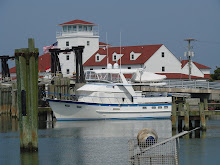As the last entry described we had a long day down the Potomac because we were anxious to move to the Chesapeake. We pulled into what the books describe as a beautiful little bay still on the Potomac but close to the mouth of the Chesapeake, and they were right. We've included some pictures of the cool little town surrounding Nomini Bay, Virgina (pronounced NO-mini).
In fact, you may not be aware, but the entire Potomac River belongs to the state of Maryland ... the state boundary line hugs the south shore of the Potomac (which is VA), so all those folks in VA with little beachfronts, step into Maryland every time they touch the water.
 This one is of an abandoned duck blind (we think).
This one is of an abandoned duck blind (we think).

The entry channel to Nomini was really narrow, with lots of crab pots just outside. We entered on mid-tide and picked our way into the bay-proper in 8 feet of water. When we got inside, we found a generally circular bay with a meandering channel to get you up-river another 5 miles, if needed. The thing that we noticed the most is the continued pattern of crab pots ... everywhere.
So, some of you may be saying ..."so what about these crab pots." Boaters quickly learn that crab pots are truely their enemy. You see, a crab pot consists of a somewhat cubical wire basket attached to a rope line or worse, a wire, which in turn is connected to the colorful little styrofoam float which you see on the surface. They used to be wood, and I've got an old one from Maine, but now-a-days they're all styrofoam. Anyway, if you happen to be the unfortunate boater that runs over one these little gems, likely it is that you will wrap the float around your prop, which of course then rapidly propels the wire mesh crab trap onto your hull, which then causes your engine to overheat ... and yep, you're quickly dead in the water. So, boaters are always wary of crab pots. End of crab pot 101.
So, having picked our way into the bay, we finally found a circular spot about 300 feet wide to drop the hook into. In 10 feet of water we generally deploy about 125 feet of chain between the anchor and bow pulpit. This usually sets us pretty good, and we can swing in a circle about 150 feet in diameter as the tide shifts. Most of the chain lays on the bottom and acts kinda like a bungee cord.
 Since we were late arriving (...about 7:15...) it wasn't long before the sun went down behind the house across the water from us, and we were treated to the following views ... although my camera can't seem to capture the red of the sun properly.
Since we were late arriving (...about 7:15...) it wasn't long before the sun went down behind the house across the water from us, and we were treated to the following views ... although my camera can't seem to capture the red of the sun properly.















